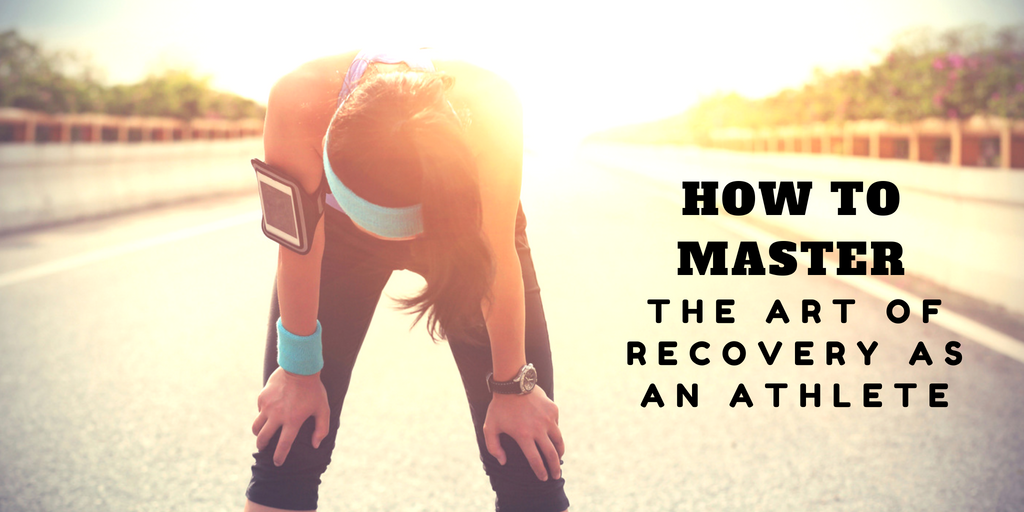How to Master the Art of Recovery as an Athlete

Whether you’re a life-long sports aficionado or a newbie in the world of fitness, you already know that every type of training comes with a steep learning curve. You constantly strive to learn new, more demanding exercises, to overcome your current personal bests, or to simply make the most out of your routine. What many versed athletes know as well is that results and success don’t happen during your workouts – they are carved in the decisions you make before and after your training session.

Recovery is one particularly complex part of this whole fitness shebang, and too many people neglect it for far too long. Of course, every effective training routine should be challenging, and the need for progressive overload in every aspect of your workout cannot be emphasized enough. Yet, the need for dealing with the resulting accumulated fatigue is equally vital, and it’s what recovery is all about.
Find the right balance, and you’re bound to see results fairly quickly. Let’s see how you can include your recovery into your workout and nutrition program, and which methods work best.

How you treat your body during your training will greatly affect its ability to heal afterward, and get ready for the next grueling workout. The following segments of your training are essential in enabling a mighty recovery process:

This one might be a no-brainer, but few people realize just how essential sleep is in the battle against fatigue. You might manage your soreness and your exhaustion even without other elements on this list, but sleep is the one part of your recovery strategy that you cannot fiddle with.
Just like you’ve given your best to craft that powerful training program, making a sleeping schedule will take half as much effort and it will yield double the results. A minimum of seven to eight hours of sleep every night goes without saying for people who train vigorously and on a regular basis. And sticking to that routine consistently is what will help you stave off chronic fatigue as well as injuries.

You’ve probably already created a diet plan for your fitness goals, whether it’s weight loss, muscle building, or simple maintenance. Keep in mind that sometimes, these goals may clash with what your body needs to recover properly, so those who are in a caloric deficit will likely feel the effects of accumulated fatigue more quickly.
However, sheer calorie counting is not enough to fine-tune your eating for the purpose of recovery. In fact, in addition to protein, which is our favorite candidate for muscle building and muscle repair, it’s carbs you should look to for replenishing energy !
Your micronutrient intake will also affect how well your body can heal, and certain minerals such as magnesium and calcium are the key components of a well-balanced diet for optimal recovery. Although it may feel like it’s impossible to keep track of all of these minuscule changes, minding your macronutrient intake and keeping an eye on certain micronutrient deficiencies is the right road to rest and recovery.

Although this may come as a surprise to many, yet another overlooked recovery factor is what you choose to pack in your gym bag. This is especially important if your routine includes movements that are taxing on your joints, if they are of high intensity, or if you are preparing for a competition. Pushing your body during workouts requires protection, and compression gear is an excellent way to support your muscles and aid in proper recovery.
But to make the most of your workout wear, keep them on even in the hours after the training is done. During summer, wearing your compression shorts post-workout can help reduce inflammation, swelling, boost your circulation, and ease those sore muscles. The same goes for tights, although they might be more comfortable for colder months, as well as other pieces such as socks and sleeves.
These innovative garments help by preventing injuries during training, giving you plenty of stability, and enabling all those workout-induced waste products circulating in your body to be flushed out with greater efficiency.

From the standard sports massage, you can book with your physiotherapist, all the way to those precious 15 minutes on the foam roller, massages in various shapes and forms can help your body relax and recover. In addition to the famous foam roller, there are other tools you can use to achieve the same, if not even better results. A great example is the peanut-shaped lacrosse ball perfect for getting rid of those tender spots in your glutes and hips, as well as for massaging your entire back.
As for your pecs, arms, shoulders, and thighs, you can feel free to use your own hands – they seem to be the best tools for getting rid of muscle tension in your body. There are various myofascial release techniques you can do yourself at home, after training, and speed up your recuperating process.

Last, but certainly not the least important in the grand scheme of all things fitness, go for a walk. Or take your pooch out for one. Go swimming or do some light yoga. Your rest days (the ones you so vigorously scheduled as early as the first segment of this blog) are no excuse to turn into a couch-potato , on the contrary.
Mild, low-intensity activities such as walks, swimming, and yoga offer just the perfect amount of light stretching, mobility, and muscle tension to ward off intense soreness and to help your body heal. Then again, there’s no need to head straight for the extreme and spend your “rest” day running around and ending up more exhausted than you would on your regular training days. Light and fun endeavors are a much better option for you than complete rest and passivity, so make sure you schedule some fun activities for your rest days!
Scarlet is a passionate writer and regular contributor at ripped.me interested in fashion, lifestyle, and health. She loves traveling, you could say that she is a real travel addict, especially when she has a chance to visit some exotic destinations. She would tell you that inspiration can be found in the most unexpected places.

Recovery is one particularly complex part of this whole fitness shebang, and too many people neglect it for far too long. Of course, every effective training routine should be challenging, and the need for progressive overload in every aspect of your workout cannot be emphasized enough. Yet, the need for dealing with the resulting accumulated fatigue is equally vital, and it’s what recovery is all about.
Find the right balance, and you’re bound to see results fairly quickly. Let’s see how you can include your recovery into your workout and nutrition program, and which methods work best.
An Athlete's Guide to Mastering the Art of Recovery
Tip 1: Start with your workout regime

How you treat your body during your training will greatly affect its ability to heal afterward, and get ready for the next grueling workout. The following segments of your training are essential in enabling a mighty recovery process:
- Hydration – Your H2O intake can either derail your exercise efforts or help you reach your fitness goals much faster. It might not do you much harm if you skip your sips for one session, but if you deprive your body of water regularly, dehydration will wreak havoc on your workouts.
- Time your rest periods – Depending on your workout system, whether you’re focusing on building strength, hypertrophy, or boosting your endurance, your rest periods will differ. Your CNS, your muscles, and your connective tissue all have different rest needs. That is why you’ll see powerlifters resting even up to five minutes between their heavy deadlift sets, while the guy who works with a higher rep range will rest about a minute.
- Please be progressive – absolutely, there should always be the element of increased effort programmed into your workouts. However, that doesn’t mean putting way too much weight on the barbell or suddenly pushing your body into running a marathon after a few weeks of gentle jogs. The purpose of “progressive” is to give your body enough time to adapt in a healthy, but challenging manner. Simply put, design your workouts to build your body, not your ego.
- Rest days – It’s wonderful if you’re so enthusiastic that you’d love to spend every waking moment at the gym. The downside of this level of dedication will be obvious down the road, when you hit a plateau, start getting injured, and your immune system plummets. Do your body a favor and schedule several rest days during the week, with ample time between each workout to recuperate.
Tip 2: Get enough shut-eye

This one might be a no-brainer, but few people realize just how essential sleep is in the battle against fatigue. You might manage your soreness and your exhaustion even without other elements on this list, but sleep is the one part of your recovery strategy that you cannot fiddle with.
Just like you’ve given your best to craft that powerful training program, making a sleeping schedule will take half as much effort and it will yield double the results. A minimum of seven to eight hours of sleep every night goes without saying for people who train vigorously and on a regular basis. And sticking to that routine consistently is what will help you stave off chronic fatigue as well as injuries.
Tip 3: Tweak your diet

You’ve probably already created a diet plan for your fitness goals, whether it’s weight loss, muscle building, or simple maintenance. Keep in mind that sometimes, these goals may clash with what your body needs to recover properly, so those who are in a caloric deficit will likely feel the effects of accumulated fatigue more quickly.
However, sheer calorie counting is not enough to fine-tune your eating for the purpose of recovery. In fact, in addition to protein, which is our favorite candidate for muscle building and muscle repair, it’s carbs you should look to for replenishing energy !
Your micronutrient intake will also affect how well your body can heal, and certain minerals such as magnesium and calcium are the key components of a well-balanced diet for optimal recovery. Although it may feel like it’s impossible to keep track of all of these minuscule changes, minding your macronutrient intake and keeping an eye on certain micronutrient deficiencies is the right road to rest and recovery.
Tip 4: Optimize your gear

Although this may come as a surprise to many, yet another overlooked recovery factor is what you choose to pack in your gym bag. This is especially important if your routine includes movements that are taxing on your joints, if they are of high intensity, or if you are preparing for a competition. Pushing your body during workouts requires protection, and compression gear is an excellent way to support your muscles and aid in proper recovery.
But to make the most of your workout wear, keep them on even in the hours after the training is done. During summer, wearing your compression shorts post-workout can help reduce inflammation, swelling, boost your circulation, and ease those sore muscles. The same goes for tights, although they might be more comfortable for colder months, as well as other pieces such as socks and sleeves.
These innovative garments help by preventing injuries during training, giving you plenty of stability, and enabling all those workout-induced waste products circulating in your body to be flushed out with greater efficiency.
Tip 5: Try your hand at massage

From the standard sports massage, you can book with your physiotherapist, all the way to those precious 15 minutes on the foam roller, massages in various shapes and forms can help your body relax and recover. In addition to the famous foam roller, there are other tools you can use to achieve the same, if not even better results. A great example is the peanut-shaped lacrosse ball perfect for getting rid of those tender spots in your glutes and hips, as well as for massaging your entire back.
As for your pecs, arms, shoulders, and thighs, you can feel free to use your own hands – they seem to be the best tools for getting rid of muscle tension in your body. There are various myofascial release techniques you can do yourself at home, after training, and speed up your recuperating process.
Tip 6: Include lighter activities

Last, but certainly not the least important in the grand scheme of all things fitness, go for a walk. Or take your pooch out for one. Go swimming or do some light yoga. Your rest days (the ones you so vigorously scheduled as early as the first segment of this blog) are no excuse to turn into a couch-potato , on the contrary.
Mild, low-intensity activities such as walks, swimming, and yoga offer just the perfect amount of light stretching, mobility, and muscle tension to ward off intense soreness and to help your body heal. Then again, there’s no need to head straight for the extreme and spend your “rest” day running around and ending up more exhausted than you would on your regular training days. Light and fun endeavors are a much better option for you than complete rest and passivity, so make sure you schedule some fun activities for your rest days!
 Author Bio:
Author Bio:
Scarlet is a passionate writer and regular contributor at ripped.me interested in fashion, lifestyle, and health. She loves traveling, you could say that she is a real travel addict, especially when she has a chance to visit some exotic destinations. She would tell you that inspiration can be found in the most unexpected places.




































































































